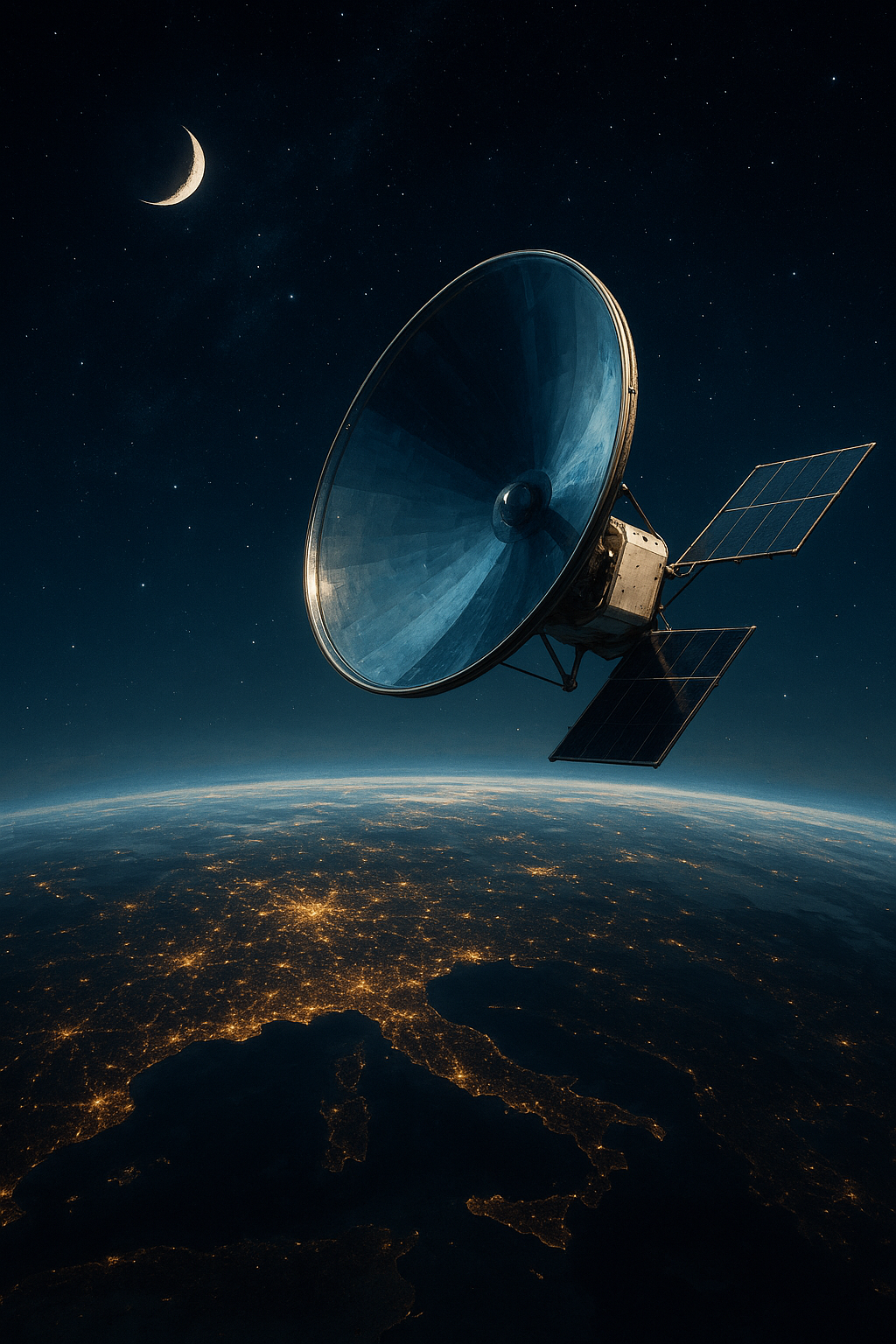Sunlight from Space: How Reflect Orbital Plans to Light the Night
I’ve mentioned before the issue with solar panels as our primary source of energy in the past, so if you remember, what I say next might not shock you.
Before sunrise, solar farms sit in silence, just rows and rows of panels waiting for the first flicker of light. They can store power, they can track the sun, but they can’t cheat night.
At least, not yet.
Somewhere above that darkness, a company called Reflect Orbital believes the dawn can be moved. Their idea is to launch mirrors into orbit, like giant, steerable ones, to bounce sunlight back to Earth long after the sun has set.
I have so many thoughts and concerns about this, it isn’t even funny.
A Startup That Wants to Light the Night
Reflect Orbital is a California-based aerospace company backed by Lux Capital, raising around $20 million in Series A funding to make an old dream possible, orbital mirrors that redirect sunlight onto solar farms, cities, or disaster zones.
Their promise is simple, “sunlight on demand.”
The concept isn’t new, the Soviet “Znamya” project in the 1990s deployed a 65-foot mirror that briefly cast a 3-mile-wide beam of light across Europe before it burned up in orbit. But Reflect Orbital is building with modern materials, precise satellite control, and AI-assisted targeting. Their plan is hundreds of lightweight mirror-like-reflectors forming a constellation that can extend daylight for energy production or emergency response.
How It Works (In Theory)
Okay, so the thought behind this is that each little satellite would carry a reflective surface, think something like giant origami Mylar sheets that can unfold in orbit. When angled correctly, they could bounce sunlight onto specific coordinates for short, timed windows.
Unlike fantasy depictions of a second sun (or a Dyson sphere), these mirrors wouldn’t flood entire cities with light. Instead, they’d provide gentle, directed illumination, just enough to keep solar panels producing power during twilight or to help rescue teams after a storm.
Reflect Orbital’s engineers describe this as “augmenting natural sunlight,” not replacing it.
The company has already conducted some small-scale balloon and ground tests, using reflective materials like mirrors to measure power gains in panels at night. Their next milestone is an orbital demonstration, expected within the next few years, a proof of concept that could redefine the limits of solar power.
It’s no surprise that we need more power. I’ve only written about it maybe 4 billion times before. You can check out my related reads at the bottom of this post to just see a tiny fraction of the amount of times I’m complaining about power that we need.
Solar power is now the cheapest energy source in human history (which is pretty epic that we finally finally got there), but its flaw is the itty bitty problem of the sun setting every day. Batteries help bridge the gap, but they’re expensive, inefficient to store long-term, and dependent on lithium mining at the moment.
If Reflect Orbital succeeds, it could create a new hybrid between solar generation and orbital engineering, an era where satellites, not smokestacks, extend the grid.
They estimate a 1% boost in global solar efficiency could offset tens of millions of tons of CO₂.
Science
So these mirrors in space would need to operate on a delicate balance of geometry and reflectivity. The sunlight they redirect is not free and perfect, it’s diffused, filtered through atmosphere, scattered by clouds, and softened by distance.
To make this project feasible, Reflect Orbital’s engineers are working on high-albedo, ultra-thin films that reflect up to 98% of incident light. Satellites use electric propulsion to maintain orientation, while AI algorithms calculate where each beam should fall.
Their goal is to hit a precision so utterly perfect they can light up a solar farm without lighting up the neighborhood next door.
The reflected light intensity would be a fraction of midday sun, strong enough to activate solar cells but below the threshold that would affect wildlife or human sleep cycles (I’ll come back to this aspect later, as I’m skeptical).
As I mentioned briefly earlier, in 1993, Russia’s Znamya 2 mission tested a space mirror that reflected sunlight over Europe for a few minutes, casting an eerie, slow-moving circle of light across the sky. It was visible from the ground, about as bright as the full moon. The experiment technically worked, but the mirror tore during deployment on its successor mission, and the project was abandoned after the Soviet collapse.
Three decades later, with AI navigation, micro-satellites, and renewable urgency, the dream is alive again in a smaller and smarter, and far more sustainable way.
Challenges & Questions I Have
Reflect Orbital’s concept, although breathtaking, faces massive headwinds.
Atmospheric scatter is a real thing with clouds and haze that can block or diffuse sunlight before it reaches panels. Even perfect mirrors can’t fix the weather. Clouds will be clouds I suppose.
Regulatory approval is definitely needed for any kind of redirecting sunlight. That kind of project means altering Earth’s natural lighting in specific areas. Agencies like the FAA, NASA, and the UN’s Committee on Peaceful Uses of Outer Space (did you know that was a thing?) would need to weigh in.
Adding hundreds of large reflective objects increases the risk of space congestion and we already have a space debris issue up there. Reflect Orbital claims its mirrors will be deorbit-ready, burning up safely after service. We’ll see I suppose.
People already complain about Starlink satellites cluttering the night sky. Imagine a constellation of glowing mirrors, imagine the light pollution then. Reflect Orbital insists their light will be “targeted and temporary”, more candle than floodlight.
For me, I’m concerned about all the plants, animals, and even bugs that rely on the sun for things like navigation, migration, just general sleep patterns. They claim it shouldn’t have any interference with them, but at my parents’ house we have to go around and pick up baby sea turtles from the sewers because the street lamps confuse them. How can something that looks like the moon not have an effect bigger than we can possibly imagine?
Still, these hurdles haven’t stopped interest. Investors see the potential for nighttime solar markets especially in places like California, India, and Australia where daylight hours dictate energy output.
Sunlight as a Service
Reflect Orbital doesn’t plan to sell satellites, they plan to sell sunlight.
The company envisions a “pay-per-beam” model where utilities, governments, or private farms could subscribe for extra illumination during important hours. Imagine an app where you schedule your sunlight delivery…so very strange.
It sounds absurd, until you realize that’s exactly how cloud computing started, shared, on-demand access to a resource too expensive to build alone. If it works, Reflect Orbital’s mirrors could join the quiet architecture of the future alongside undersea internet cables, stratospheric Wi-Fi balloons, and solar satellites.
Sunrise being adjustable is one of the wildest concepts I’ve heard all day. I like to think about how if it works a solar farm in Norway can use twilight power from a beam reflected off a satellite 600 kilometers above. Instead of burning the night to make light, we bend the day.
The Bigger Picture
For all its beauty, the idea raises questions about control like who gets to own daylight?
Who pays for it, who profits, and who decides when it shines?
Last I checked the sunlight was all of ours, and we didn’t need to schedule or pay for a couple hours here or there.
Reflect Orbital’s founders insist their goal is sustainability, but the line between innovation and dominance in space is thin. When sunlight becomes a service, it becomes a business. And when it becomes a business, it becomes a power.
The next few years will decide whether Reflect Orbital’s vision glows or burns out. A single test mirror, if launched successfully, could rewrite our relationship with both night and nature.
We once worshiped the sun, then we learned to bottle it, now, we’re learning to aim it.
Who knows what we’ll think of next.
Reads You Might Enjoy:
Space Power, Super Panels, and the Future of Global Energy: Japan’s Wild Leap Toward Sci-Fi Reality
Why Scientists Are Trying to Dim the Sun — and What It Could Mean for Us All
How the Brain Reacts to Light Pollution: What Happens When We Forget the Night
Artificial Photosynthesis Could Power the Future, And It’s Closer Than You Think
Solar Tracks and Alpine Dreams: How Switzerland Turned Its Railways Into a Solar Farm
When the Light Becomes Too Bright: How a Quasar Silenced the Sky
When the Moon Sings with Power: NASA’s 2030 Lunar Reactor and the Dawn of a New Chapter
We Are Vessels of Light: How Sunlight Moves Through Us and Mends Our Vision

